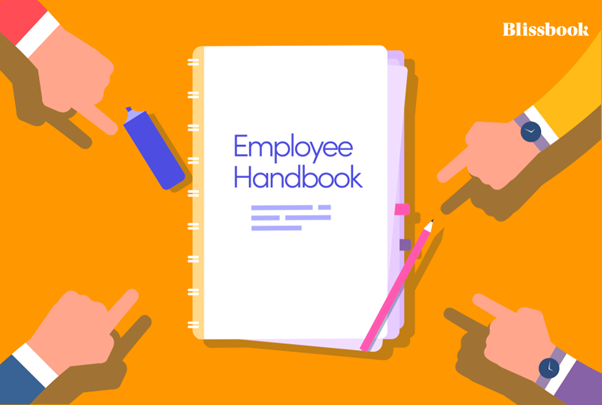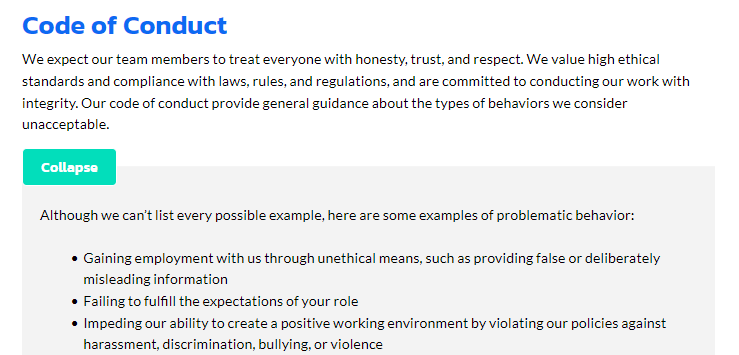Employee Handbook vs. Code of Conduct: Differences
Creating an employee handbook and a code of conduct might seem challenging, but it’s crucial for setting the stage in any workplace. In this article, we’ll clarify the distinctions between these two essential documents, helping you understand their individual roles and importance. An employee handbook is your foundational tool for outlining company policies, setting clear expectations, and defining workplace culture. It’s vital for ensuring that everyone is informed and on the same page from day one.
Similarly, a code of conduct is key to establishing the ethical framework and behavioral expectations within your company. It helps maintain integrity and professionalism, outlining what is considered acceptable and unacceptable behavior.
Why focus on distinguishing these documents? While both are important, they serve different purposes and are used under different circumstances. Understanding these differences is not only beneficial for compliance but also for improving the effectiveness of your internal communications and governance. So, if you’re aiming to understand these concepts without getting lost in the complexity, stay tuned as we break down the specifics of each document, ensuring you can implement them effectively in your business.
What is an Employee Handbook?

An employee handbook is a comprehensive resource that outlines the company’s policies, workplace procedures, employee benefits, and overall culture. It serves multiple purposes: setting clear expectations for employees, providing guidance on various company policies, and helping to establish a consistent approach to day-to-day operations. The handbook is an essential tool for both new and existing employees, assisting them in navigating the workplace effectively.
Key Components of an Employee Handbook
The contents of an employee handbook can vary from one organization to another, but there are several key components that are generally included:
- Employment Policies: This section covers job classifications, employee records, work schedules, and employment termination conditions.
- Workplace Procedures: These are the daily operational guidelines that govern employee actions in the workplace, such as the use of company property, internet and email use, and confidentiality agreements.
- Company Benefits: Details about health insurance, retirement plans, paid time off, and other perks are explained here. It’s where employees find out what benefits the company offers and how they can qualify for them.

- Legal Obligations: The handbook also informs employees about their rights and the company’s legal duties, including equal employment opportunities, ADA (Americans with Disabilities Act) accommodations, and FMLA (Family and Medical Leave Act) rights.
Role in Onboarding and Daily Operations
During the onboarding process, the employee handbook plays an important role in bringing new hires up to speed on how the company operates. It’s one of the first detailed pieces of documentation that new employees receive, making it foundational for setting expectations right from the start. Beyond onboarding, the handbook is a go-to resource for current employees who need reminders about policies or procedures, helping to maintain consistency and order within the workplace. Regular reference to the handbook can help in resolving conflicts and ensuring that company standards are upheld consistently.
What is a Code of Conduct?
A code of conduct outlines the ethical and professional standards expected of employees. It aims to guide behavior, ensuring that all employees act in a manner that upholds the company’s values and maintains a professional environment. It is usually a policy found within an employee handbook.

Key Elements of a Code of Conduct
The code of conduct includes several critical elements designed to guide employees in their daily interactions and decision-making processes:
- Ethical Guidelines: This section addresses the broader ethical principles that the company expects employees to follow, such as integrity, fairness, and respect for others.
- Compliance Rules: These are specific regulations that relate to legal compliance in all areas of business operations, including but not limited to anti-bribery laws, data protection acts, and industry-specific legal requirements.
- Expectations for Professional Behavior: Here, the document outlines the expectations regarding employee interactions, conflict resolution, and the overall professional demeanor expected at work. This section often includes policies on harassment, discrimination, and other workplace conduct issues.
Role in Maintaining Workplace Integrity and Culture
The code of conduct is vital for maintaining workplace integrity and culture. It acts as a basis for the expected behavior of all employees, helping to prevent unethical actions and promoting a culture of honesty and respect. When employees adhere to a well-defined code of conduct, it helps create a trustworthy and secure environment where everyone knows the boundaries and respects them. Moreover, the code of conduct supports the company’s mission and vision, and values, aligning the daily actions of its workforce with the broader goals of the organization.
Key Differences and Similarities Between an Employee Handbook and a Code of Conduct
Understanding the distinctions between an employee handbook and a code of conduct is crucial for both employers and employees. These documents serve different purposes and are utilized differently within an organization. Aside from what was aligned above, here are the key differences and similarities between the two:
Legal Standing and Implications
Neither document is a legally binding contract in its entirety (unless explicitly stated), but both include enforceable elements under the law. The employee handbook often incorporates the code of conduct, focusing on broader policy and operational guidance, while specific sections of the code may be legally binding due to compliance requirements.
Scope and Detail
The handbook offers a comprehensive overview of employment and workplace norms, whereas the code of conduct is more focused on ethics and professional behavior.
- Employee Handbook: This document covers a broad range of employment aspects including job descriptions, employee benefits, workplace safety, and procedural information such as leave policies and grievance procedures. It is designed to be comprehensive, providing clear guidelines on what the organization expects from its employees and what employees can expect in return.
- The Code of Conduct focuses more specifically on ethics and professional behavior, detailing the principles and values of the organization along with specific examples of acceptable and unacceptable behaviors. It guides employees in making ethical decisions and managing professional relationships both within and outside of the company.
Application and Enforcement
The handbook is distributed to employees at the start of employment and enforced through HR-led disciplinary actions if necessary. The code of conduct is typically reinforced through continuous ethics training and overseen by committees focusing on integrity and compliance.
- Employee Handbook: Distributed at the start of employment, the employee handbook serves as a detailed guide for company policies and procedures. Enforcement of the policies within the handbook is managed by HR and can involve formal procedures, including disciplinary actions.
- Code of Conduct: Introduced during initial training and revisited in ongoing ethics training, the code of conduct guides ethical and professional behavior. Enforcement of the code frequently involves an ethics committee or similar body within the organization that handles violations and determines appropriate disciplinary measures.
In summary, the employee handbook and the code of conduct are integral parts of organizational documentation but serve complementary roles. The handbook is a comprehensive resource that often includes the code of conduct, detailing expected behaviors and operational policies. While the handbook guides day-to-day operations and broader workplace aspects, the code focuses on ethical conduct and compliance. Both are enforced through training, oversight, and disciplinary measures as needed, ensuring agreement to company standards. Understanding their interrelationship is key to effective implementation and enforcement within any organization.
Best Practices for Creating and Maintaining These Documents
Create Clear and Comprehensive Handbooks and Codes of Conduct
Start by ensuring clarity and completeness in your employee handbooks and codes of conduct. These documents should unambiguously detail all necessary policies, procedures, and expected behaviors. Involve stakeholders from various departments for a holistic perspective that covers all essential aspects of the organization’s operations and ethics. Use straightforward language to make the content accessible to everyone in the organization.

Regular Updates and Legal Compliance
Regular updates to both the employee handbook and the code of conduct are essential to keep pace with changing laws, regulations, and business practices. An outdated document can lead to compliance issues and misunderstandings about policies. Establish a regular review cycle—annually, at minimum—to assess and update these documents. This process should involve checking for legal compliance, adapting to new business strategies, and integrating employee feedback to ensure relevance and effectiveness.
Promote Awareness and Understanding
Simply distributing these documents is not enough; active efforts must be made to guarantee that all employees understand and follow the guidelines laid out within them. Implement comprehensive training sessions as part of the onboarding process and as ongoing education for all employees. Use interactive elements such as quizzes or practical scenarios to help employees better understand the content. Regularly reinforce the importance of these documents in maintaining a safe, ethical, and compliant workplace environment.
By applying these best practices, organizations can make sure that their employee handbooks and codes of conduct would be effective tools for guiding employee behavior and supporting organizational goals.
Final Thoughts
The employee handbook and the code of conduct might be two separate documents, but integrating them effectively is key to reinforcing your company’s values and day-to-day norms. This integration helps keep everything legally above board and plays a huge role in creating a unified and positive company culture.
Here’s how it works: the handbook provides a comprehensive overview, detailing not just rules and procedures, but also employee benefits and the overall workplace culture. Meanwhile, the code of conduct focuses on the expected behaviors, and serves as a guide for how employees should conduct themselves to uphold the company’s values.
When you mesh these documents together well, they form a complete guide for daily work and help promote a culture that values ethical decisions and compliance throughout the company.
As business environments and regulations continually evolve, it’s important for businesses to keep their workplace documents up-to-date. We recommend using Blissbook for crafting, reviewing, and updating your employee handbook and code of conduct. Blissbook offers an intuitive platform that simplifies the creation and maintenance of these major documents, ensuring they meet current standards and reflect your company’s values effectively.
For more information on how Blissbook can streamline this process, or start creating a personalized and compliant handbook today, please visit Blissbook and request a demo now or chat with us. This is an opportunity to start taking proactive steps towards enhancing your HR practices.